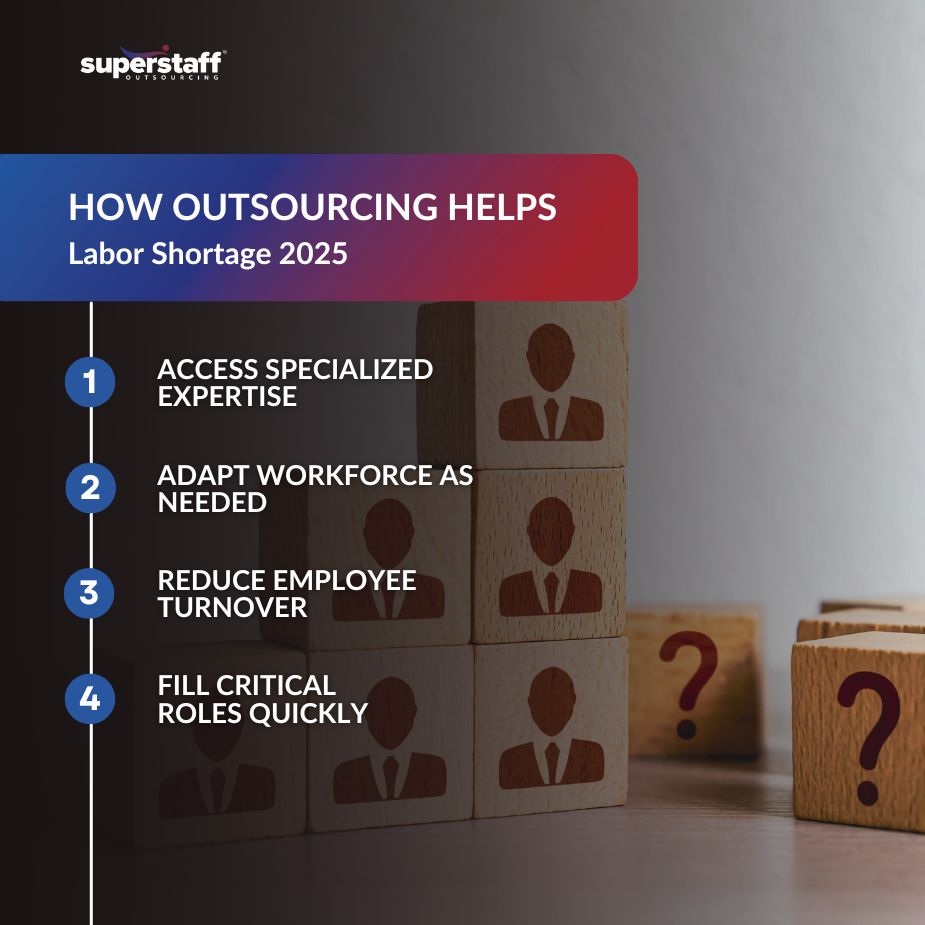
Outsourcing as the Answer to the 2025 Labor Shortage: How Businesses Are Filling Critical Gaps
The labor shortage 2025 is a pressing reality for businesses today. With an aging workforce and fewer young people entering the job market, many companies are struggling to find the workers they need to keep operations running smoothly. At the same time, technological advancements are creating a growing demand for specialized skills, which are in short supply.
So, how can businesses adapt? Many are turning to outsourcing as a way to bridge the gap. By partnering with external teams, companies can quickly fill important roles and avoid the delays that come with traditional hiring. Outsourcing offers flexibility, allowing businesses to meet their needs without committing to long-term hires.
But there’s more to outsourcing than just solving short-term staffing issues. It’s becoming a key strategy for businesses to remain flexible and prepared for the challenges ahead. Keep reading to discover how outsourcing can help your business navigate the labor shortage 2025 and thrive in a changing workforce landscape.

The Labor Shortage 2025: Why It’s Happening and What It Means for Businesses
Several factors are driving this issue, and these changes are reshaping the workforce in lasting ways. Businesses will need to adjust their hiring and team management strategies to stay competitive.
-
Aging Workforce
Many Baby Boomers are retiring, and there aren’t enough younger workers to replace them. As these retirees exit the workforce, industries face challenges in filling positions, particularly those requiring specialized skills.
The U.S. Department of Labor highlights that the retirement of aging Baby Boomers will significantly impact the economy, creating a need for younger workers to fill the vacated jobs, many of which require relatively high levels of skill.
-
Declining Birth Rate
Fewer people are entering the workforce, which shrinks the talent pool. This demographic shift is expected to continue, further limiting the availability of younger workers to replace the aging workforce.
-
Skills Gap
Industry demands are evolving quickly, but the workforce isn’t keeping up with the skills needed. Many businesses are investing in reskilling initiatives, but the pace at which workers are acquiring these new skills still lags behind the speed of technological advancements.
-
Shifting Work Preferences
More people want flexible work arrangements like remote or hybrid setups. This shift in expectations is causing businesses to rethink their workplace policies to stay competitive in attracting and retaining talent.
-
Increased Talent Competition
Certain industries, such as healthcare and technology, are facing intense competition for top talent. As these sectors continue to grow, organizations are offering more attractive incentives and career growth opportunities to secure the best candidates.
What Does This Mean for Businesses?
The effects are already being felt. More job openings are going unfilled, while fewer applicants are applying for positions. Companies are facing increasing pressure to devise innovative solutions to maintain smooth operations.
The traditional hiring model, with its lengthy recruitment processes and high costs, is no longer enough to meet the demands of today’s market. Businesses must rethink their approach to workforce management to remain competitive.
The Impact of the Labor Shortage on Business Operations and Growth
Labor shortages affect many parts of a business, not only hiring. Companies are facing serious challenges that go beyond recruitment.
-
Rising Hiring Costs
To attract talent, companies must offer higher salaries, better benefits, and more incentives. This increases recruitment costs, which can be especially tough for smaller businesses.
-
Missed Opportunities for Growth
Without sufficient staff, businesses are compelled to postpone or scale back their expansion plans. This limits their ability to take on new projects or explore new markets.
-
Increased Employee Burnout
With fewer employees, those who remain are expected to do more work. This leads to higher stress, lower morale, and a drop in productivity. Over time, burnout can also cause existing workers to leave, worsening the staffing problem.
-
Difficulty Filling Specialized Roles
Positions that require specialized expertise, such as IT professionals or healthcare specialists, are the most difficult to fill. This can cause delays in projects, impact service quality, and leave businesses unable to meet customer demands.
As staffing shortages persist, performance suffers. Companies struggle to meet customer expectations, hit deadlines, and pursue new opportunities, making it harder to stay competitive. Solving employee shortage 2025 becomes more urgent as businesses face these operational challenges.
Outsourcing as a Flexible and Scalable Solution to Labor Shortages
Outsourcing provides a strategic approach to managing workforce shortages caused by the labor shortage 2025 without overloading your internal team or straining your budget. Here are the benefits of staffing shortages outsourcing:
-
Access to Specialized Expertise
Instead of trying to train or recruit for specialized roles internally, outsourcing allows businesses to tap into niche skills that may be difficult to find locally. This helps fill complex positions quickly and effectively.
-
Adaptable Workforce
Outsourcing provides the ability to adjust staffing levels as needed. Whether it’s scaling up during peak seasons or reducing headcount after a project, businesses can maintain the right number of employees for any given situation.
-
Reduced Employee Turnover
By outsourcing specific tasks, you can ease the burden on your core team, reducing the risk of burnout and lowering turnover rates. This can help maintain morale and improve long-term productivity.
-
Mitigated Risk of Talent Gaps
Outsourcing can help avoid prolonged gaps in critical roles, ensuring that even if a position becomes vacant, work continues without major disruption. This is especially important for businesses dealing with high-demand or hard-to-fill roles.
Instead of struggling to fill each position internally, outsourcing helps businesses stay nimble, maintain service levels, and focus on growth, even during labor shortages.
The Long-Term Benefits of Outsourcing During Labor Shortages
Outsourcing helps businesses solve immediate hiring issues and also strengthens their operations for the future. By working with external partners, companies can build a flexible workforce that adapts to changing demands while keeping costs manageable. This approach not only addresses current staffing gaps but also improves long-term scalability and resilience.
- Better Agility – Easily adapt to market shifts or customer needs without the lag of traditional hiring.
- Cost Control – Pay only for the work you need, when you need it—no long-term commitments required.
- Focus on Core Activities – By outsourcing support roles, your internal team can focus on growth and innovation.
- Workforce Scalability – Adjust workforce size as your business grows, without increasing overhead or administrative burden.
Outsourcing enables companies to adapt quickly without being locked into rigid structures. It helps build teams that can grow, shrink, or shift focus as needed, keeping businesses competitive during the labor shortage 2025.
Outsourcing as Part of a Broader Workforce Strategy for 2025
Outsourcing can play an important role in helping businesses plan for long-term success and growth.
- Build Long-Term Partnerships: Working with trusted outsourcing providers can help businesses maintain steady quality and performance over time. These partnerships align with business goals and ensure reliable support.
- Plan for Business Continuity: Outsourcing ensures that business operations can continue without interruption, even when internal teams are stretched. This helps businesses keep running smoothly and meet customer needs.
- Support Internal Growth: By outsourcing routine tasks, businesses give internal teams the chance to focus on more important work. Employees can develop new skills and work on projects that help the business grow.
- Drive Innovation: Outsourcing helps businesses free up time and resources, allowing them to focus on new services, technologies, or markets that can help them stay competitive.
What’s your long-term workforce plan?
If outsourcing is not part of your strategy, it may be an important tool for helping your business grow and succeed in the future.
Take Action Before the Labor Shortage Slows You Down
The labor shortage 2025 is a growing challenge, but it doesn’t have to hold your business back. By integrating outsourcing into your workforce strategy, you can stay productive, competitive, and ready for what’s ahead.
Now is the time to act. Don’t wait until the labor shortage begins to affect your business. Begin building your outsourcing strategy today to ensure you have the necessary talent and support.
Partner with SuperStaff to see how outsourcing helps solve the 2025 labor shortage by providing experienced professionals, cost-effective solutions, and scalable staffing options that align with your specific business needs. Let’s work together to create a stable, flexible workforce that supports your growth in 2025 and beyond.






